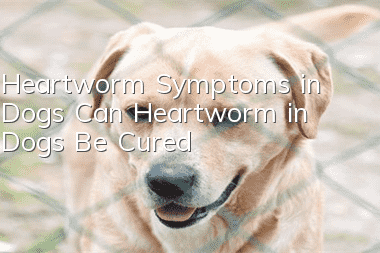Heartworm Symptoms in Dogs Can Heartworm in Dogs Be Cured?

Canine heartworm disease
This disease is caused by canine heartworm parasitizing the right ventricle and pulmonary artery (rarely found in the chest and bronchi) of dogs, causing symptoms such as circulatory disorder, dyspnea and anemia. A silk disease. In addition to infected dogs, cats and other wild carnivores can also be infected. This disease is widely distributed in my country, and has been found as far north as Shenyang and as far south as Guangzhou.
Canine heartworm disease pathogen and its life history
Canine heartworm (also known as dog heartworm) is yellow-white and elongated in the shape of a fan. The male worm is 120~160 mm long, with a spirally curled tail; the female worm is 250~300 mm long. The viviparous larvae are called microfilariae, which live in the blood. They are 307 to 322 microns long and have no sheath. To complete the life cycle of dog heartworm, dog fleas, Anopheles mosquitoes or Culex mosquitoes are required as intermediate hosts. The female parasite parasitizing the right ventricle produces microfilariae that can move freely and enter the blood. When fleas and mosquitoes suck blood, they inhale the microfilariae into the body. They develop into infective larvae and enter the mouths of fleas and mosquitoes. When fleas and mosquitoes suck blood, When the larvae escape from the mouth and burrow into the skin of the final host, they circulate to the heart and canine blood vessels through subcutaneous lymph or blood.
Key points for diagnosis of canine heartworm disease
(1) Clinical symptoms: The earliest symptom is chronic cough, but there are no other symptoms of upper respiratory tract infection. It is aggravated during exercise, or the sick dog is prone to fatigue during exercise. . As the disease progresses, sick dogs develop hyperpalpitations, weak and intermittent pulses, and murmurs in the heart. The liver area is painful on palpation and hepatomegaly. Fluid accumulation in the chest and abdomen, and edema all over the body. Difficulty breathing. In cases of long-term infection, pulmonary heart disease is very obvious. In the final stage, death occurs due to general weakness or collapse during exercise. Sick dogs are often accompanied by nodular dermatosis, which is characterized by itching and multiple focal nodules that tend to rupture. Skin nodules are pyogenic granulomatous inflammation in the center of blood vessels, and microfilariae are common in the blood vessels around pyogenic granulomas. X-ray photography shows right ventricular dilation, aorta, and pulmonary artery dilation.
(2) Laboratory microscopy: A preliminary diagnosis can be made based on medical history investigation and observation of clinical symptoms. For final diagnosis, peripheral blood should be collected for microscopic examination at night to find microfilariae.
Measures for prevention and control of canine heartworm disease
(1) Deworming: To kill adult worms: Apply sodium thiarsacamide at a dose of 2.2 mg/kg body weight, intravenously, twice a day, continuously Two days. During intravenous injection, the drug should be injected slowly, and the liquid should not leak out of the blood vessels to avoid causing tissue inflammation and necrosis. Or use dichlorophenylarsine hydrochloride at a dose of 2.5 mg/kg body weight, intravenously, once every 4 to 5 days. This drug has a strong anthelmintic effect and low toxicity.
To expel microfilariae: Use levopyrimidine at a dosage of 10 mg/kg body weight, orally, for 15 days. Test the blood after the sixth day of treatment. When no microfilariae can be detected in the blood, stop treatment. Or use ivermectin (trade name: lvomec), the dosage is 0.05~0.1 mg/kg body weight, one intradermal injection. Or useFenthion, subcutaneously inject 0.2 ml of 7% solution per kilogram of body weight, repeat 1 to 2 times at 2-week intervals if necessary. Symptomatic treatment should also be carried out according to the condition.
(2) Prevent and eliminate intermediate hosts: Preventing and eliminating fleas and mosquitoes are important measures to prevent this disease. Drug prevention can also be used: Diethylcarbamazine (Haiqunsheng) is taken orally at a dose of 6.6 mg/kg body weight, and should be used continuously during the mosquito and fly activity seasons. For microfilaria-positive dogs, it is strictly forbidden to use diethylcarbamazine. The adult worms and microfilariae must be killed with medication before starting to use diethylcarbamazine for prevention.
- What do dogs eat to protect their stomach? It is important to protect their stomach and treat gastrointestinal diseases in dogs.
- How to tell if your dog is fat? Is your dog overweight?
- Will your dog catch a cold if you blow the air conditioner? What should you do if your dog catches a cold if you blow the air conditioner?
- What should you pay attention to when your dog drinks water? Don’t be careless when it comes to your dog’s drinking water.
- The dog's mouth bites and shakes. Why does the dog's mouth occasionally shake and bite?
- How to cut a dog's hair? Do you know how to cut a dog's hair correctly?
- Can dogs eat raw eggs? Why can’t dogs eat egg whites?
- Common Dog Problems in Summer How to Deal with Different Dog Problems
- How to keep dogs away from skin diseases. If you do this, will you see if your dog will still be infected with skin diseases?
- What causes anorexia in dogs? Dogs will become anorexic due to lack of exercise. Hounds run at least 5KM every day.



